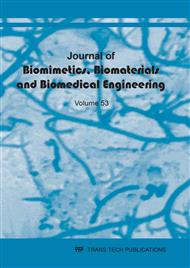[1]
Vasilkov G. V. Evolutionary theory of the life cycle of mechanical systems. Theory of structures. - M.: LKI Publishing House, 2018. 320 p.
Google Scholar
[2]
Lipov A.N. At the origins of modern bionics. Bio-morphological casting in an artificial environment // Polignosis. No.1-2. 2010. Part 1-2. P. 126-136.
Google Scholar
[3]
Marteka V. Bionics, transl. from English, M., (1967).
Google Scholar
[4]
Muller T. Biomimetics: National Geographic Russia, May 2018, pp.112-135.
Google Scholar
[5]
Bencini A., Lippolis V. Probing biologically and environmentally important metal ions with fluorescent chemosensors: Thermodynamic versus optical response selectivity in some study cases. // Coordination Chemistry Reviews. – 2012. – V. 256. – № 1–2. – P. 149-169.
DOI: 10.1016/j.ccr.2011.05.015
Google Scholar
[6]
Wallace G.G., Teasdale P.R., Spinks G.M. Kane-Maguire L.A.P. Synthesis of Polyanilines in Conductive Electroactive Polymers. 2008. – CRC Press. – P. 137-178.
DOI: 10.1201/9781420067156
Google Scholar
[7]
Emelyanov V.V., Kureichik V.V., Kureichik V.N. Theory and practice of evolutionary modeling. – M: Fizmatlit, (2013).
Google Scholar
[8]
Architectural bionics. Edited by Yu. S. Lebedev -M.: Stroyizdat, 1990. 269p.
Google Scholar
[9]
Braines S.N., Svechinskiy V.B. Problems of neurocybernetics and neurobionics, M., (2008).
Google Scholar
[10]
Parin V. V., Baevsky R. M. Cybernetics in medicine and physiology, M., (2013).
Google Scholar
[11]
Bar-Cohen Y. Introduction to Biomimetics in Biomimetics. 2005. – CRC Press. – P. 1-40.
Google Scholar
[12]
Schmitt O.H. Some interesting and useful biomimetic transforms. in Third International Biophysics Congress. Boston, Massachusetts, USA. – (2009).
Google Scholar
[13]
Bibliographic index on bionics, M., (2005).
Google Scholar
[14]
Issues of bionics. Collection ofArticles., ed.-in-chief M.G. Gaaze-Rapoport, М., (2017).
Google Scholar
[15]
Ignatiev M. B. Artonika // Article in the reference dictionary Systemic analysis and decision making, ed. Vysshaya shkola, M., (2014).
Google Scholar
[16]
Kraizmer L. P., Sochivko V. P. Bionics, 2nd ed., M., (2008).
Google Scholar
[17]
Lipov A.N. At the origins of modern bionics. Bio-morphological casting in an artificial environment // Polignosis. No. 3. 2010. Part 3. P 80-91.
Google Scholar
[18]
Litinetskiy I.B. Conversations about bionics. – M .: Nauka. Chief editorial board of physical and mathematical literature, 1968. – 592 p. – 50,000 copies.
Google Scholar
[19]
Modeling in biology, trans. from English, ed. N. A. Bernshtein, M., (2013).
Google Scholar
[20]
Karyakin A.A., Strakhova A.K., Yatsimirsky A.K. Self-doped polyanilines electrochemically active in neutral and basic aqueous solutions. Electropolymerisation of substituted anilines. // Journal of Electroanalytical Chemistry. – 2014. – V. 371. – P. 259-265.
DOI: 10.1016/0022-0728(93)03244-j
Google Scholar
[21]
Velusamy V., Arshak K., Korostynska O., Oliwa K., Adley C. An overview of foodborne pathogen detection: In the perspective of biosensors. // Biotechnology Advances. – 2010. – V. 28. – № 2. – P. 232-254.
DOI: 10.1016/j.biotechadv.2009.12.004
Google Scholar
[22]
Pliura, A., Suchockas, V., Sarsekova, D., Gudynaite, V. - Genotypic variation and heritability of growth and adaptive traits, and adaptation of young poplar hybrids at northern margins of natural distribution of Populus nigra in Europe // Biomass and Bioenergy, 2014, 70, P. 513–529.
DOI: 10.1016/j.biombioe.2014.09.011
Google Scholar
[23]
Sukmana B.I., Edyson, Thahir H., Achmad H., Huldani, Bokov D.O. Research review on secondary metabolite compounds of Mangifera casturi bark and their functions. International Journal of Pharmaceutical Research. 2020; 3(12): 2155-2161.
DOI: 10.31838/ijpr/2020.12.03.309
Google Scholar
[24]
Achmad H., Huldani, Carmelita A.B., Fauziah, Hidayah N., Bokov D. Antioxidant and antiviral potential of brown algae (Phaeophyceae). International Journal of Pharmaceutical Research. 2020; 3(12): 2117-2125.
Google Scholar
[25]
Simonyan, G.S., Simonyan, A.G., Sayadyan, M.L., Sarsekova, D.N., Pirumyan, G.P. - Analysis of environmental status of wood and shrub vegetation by the armenian index of environmental quality // Oxidation Communications, 2018, 41(4), P. 533–541.
Google Scholar


